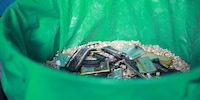
Background information
A mobile's final journey (part 2): how harmful substances are disposed of safely
by Martina Huber

Gold, silver, copper – there are numerous reusable materials in old phones that can be recovered. Lithium batteries are a particular challenge when it comes to recycling. They can ignite and even explode when they're damaged.
We're on-site with Solenthaler Recycling AG (Sorec) in Gossau SG, one of almost 20 recycling companies which recycles disused electric and electronic devices. I'm here to see for myself what happens with unwanted mobile phones and other devices after we've dropped them off in a shop or at a collection point.
Seven smartphones sit on the hotplate of a safety workbench ready to be opened. Jean-Pierre picks one up, guides the smooth underside of the device to a metal spike fixed to the worktop and hits it with a hammer several times. He pushes a screwdriver into the resulting gap. A few movements later, the inner workings of the smartphone are visible. The lithium battery is stuck, but the glue has been softened on the hotplate. Jean-Pierre can now pick the battery out without damaging it. «A battery can get hot by simply bending it,» he explains. «Sometimes it ignites or explodes if you damage it.» That's why Jean-Pierre wears gloves while he's working. It's also why he's protected by a safety screen and an extraction system, which absorbs corrosive gases in the event of an explosion, and there's always a fire extinguisher on hand.
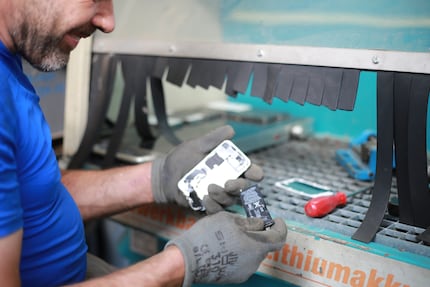
The old devices in Gossau are just a tiny fraction of a huge amount of waste equipment discarded. The worldwide figure for 2019 was a shocking 53.6 million tonnes of disused devices. This was the finding of the Global E-waste Monitor 2020 report, published in July by the United Nations University, the International Telecommunication Union (ITU) and other institutions.
This equates to 7.3 kg for each person on Earth. 17.4% of this is demonstrably recycled, but we don't know exactly what happens to the remaining 82.6%. And if nothing changes, the problem will only be exacerbated in the future: according to the report, global consumption has steadily increased in recent years. If this trend continues, the figure in question will already have risen to 74 million tonnes of old devices per year by 2030 – 7,400 times the weight of the Eiffel Tower.
Electrical and electronic equipment (EEE) has become an essential part of everyday life. Its availability and widespread use have enabled much of the global population to benefit from higher standards of living. However, the way in which we produce, consume, and dispose of e-waste is unsustainable.
These are old devices that contain damaging substances such as quicksilver and PCBs or greenhouse gases that are more than 1,000 times more harmful to the environment than CO2. The unwanted devices also contain reusable materials that could replace primary raw materials if they're recovered successfully. The report estimates the value of gold, copper, iron and other raw materials from 2019's e-waste at 57 million US dollars. All of this is reason enough for me to take a closer look at the issue.
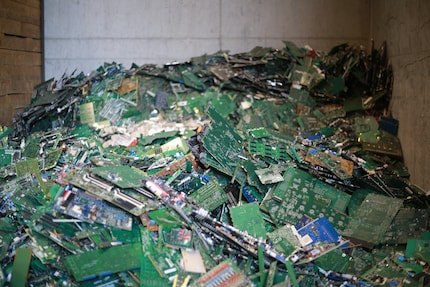
I found detailed information on Switzerland in the Technical Report 2020 by the three take-back systems SENS, Swico and SLRS. It states that 95% of old electrical and electronic equipment in Switzerland is disposed of at collection points and specialist shops and processed by recycling plants. This amounted to 127,000 tonnes of unwanted devices in the previous year, which is around 15 kg per resident. This included 35,800 tonnes of large electrical appliances, such as ovens or washing machines, 19,900 tonnes of refrigerators, freezers and air conditioning units, 28,700 tonnes of small electrical appliances and 41,000 tonnes of electronic devices. Of the latter, 5,176 tonnes were printers, 1,233 tonnes were laptops, 4,649 tonnes were PC monitors and 124 tonnes were mobile phones. The latter have increased by 6% compared to 2016, although the increase would have been significant if the average weight of a mobile phone hadn't simultaneously reduced.
What happens to all these devices? What reusable materials are still in them? What happens to any harmful substances? A visit to the Sorec recycling plant in Gossau should at least give me an idea. So, one September afternoon, I went to see the site, the nearby collection point and the Dock St. Gallen cutting plant for myself, where old devices are manually dismantled after collection before they are further processed mechanically in the Sorec grinders. And the safety workbench where Jean-Pierre dismantles potentially dangerous devices. Devices like smartphones, tablets and e-books which have lithium batteries glued into them and can only be opened with force.
Around two tonnes of these devices are dismantled here every year, explains Markus Stengele, environmental engineer and Head of Quality and Environment at Sorec, who guided me around the business. He has worked in electronic waste for more than 20 years and tells me that the proportion of old devices that contain lithium batteries has shot up in that time. «There probably isn't an electronic waste recycler in existence that hasn't had a fire due to a lithium battery,» he adds. «It can be dangerous when the batteries are damaged because they get too hot or there's a short circuit. They can self-ignite.» The combustion point of the solvent inside is the same as methylated spirits, and a lithium battery contains around ten times the stored electrical energy in the form of thermal energy, Stengele says.
This is why the batteries that Jean-Pierre removes from the devices end up in a UN-approved steel container. It's waist-high and already three-quarters full of batteries and something that looks a bit like gold cat litter. «Vermiculite,» he explains and picks up a few of the gold grains to show me how easy they are to shape between his thumb and index finger. «It's soft and light like Styrofoam. It's an insulator, protects against impact, absorbs escaping liquids – and if a battery ignites, the material more or less melts around it. And it has the advantage of not separating when being transported.»
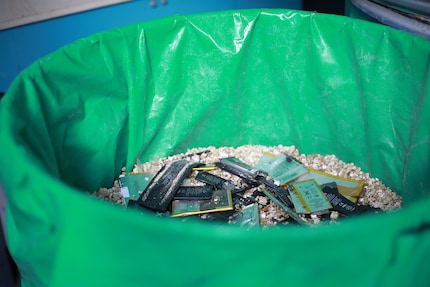
There have also been attempts to fill the containers with glass foam balls, he explains. «They have good insulation properties too. But the problem is that, after transportation, all the batteries end up at the bottom and the glass balls at the top. The inside of the container is lined with plastic wrap to prevent direct contact between the steel and the batteries and resulting short circuits. A ventilation valve in the lid allows gas to escape in the event of a fire. «This allows us to store and transport powerful batteries from e-bikes ourselves without having to worry that the whole thing will go up in flames.»
In steel containers like these, batteries are delivered to Batrec Industrie AG in Wimmis in Bern, where Stengele tells me they are shredded in a protective atmosphere and processed so that there's no further risk of fire. The components are then sent abroad to a plant where cobalt in particular is recovered – the lithium is lost in this process. «Cobalt is a dirty metal,» says Stengele. It's also often sourced under very questionable conditions, such in the Democratic Republic of the Congo, where children and adults frequently risk their lives to haul it out of hand-dig tunnels in jute sacks. It's also quite toxic. At the same time, the metal is currently used a lot for powerful batteries, and increasing numbers of electric-powered vehicles mean that it will become ever more important in the future. Lithium batteries can be made without cobalt, but this could mean lower output density. Batteries from mobile phones, tablets and laptops tend to contain cobalt nowadays. «Cobalt is valuable, we should recover as much of it as we can.»
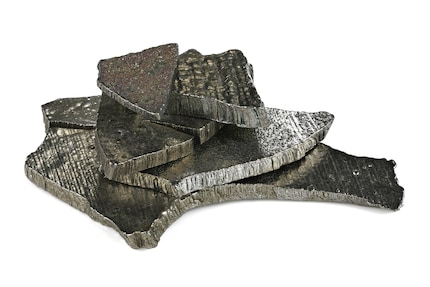
The gold, platinum, copper and other precious metals on the circuit boards of computers, tablets and mobile phones are also valuable. «There's much more of them in old mobiles than smartphones,» says Stengele. «You see gold practically painted on circuit boards built 30 years ago. Today, there's just a hint of it on the contacts.» However, modern smartphones are also made from extremely high-quality materials. Where he can do so easily, Jean-Pierre removes displays and plastic components along with metal covers and cases. The former go to an incinerator, the latter to the company's sorting facility. The rest goes to the Umicore smelting plant in Belgium, one of three European smelting facilities that have specialised in the recovery of precious metals from circuit boards and other electronic components.
According to Heinz Böni, who leads the Critical Materials and Resource Efficiency research group at Swiss Federal Laboratories for Materials Science and Technology (Empa), multi-step process technology means that 20 different metals can be recovered in these smelting works. «A single mobile contains little metal, but a tonne of old phones contains around ten times more gold than the ore from a gold mine. And other metals are found in higher concentrations in old mobile phones than they are in the ore from primary degradation.»
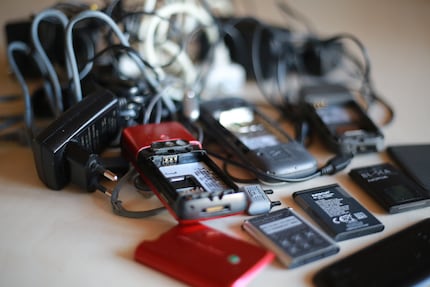
According to Judith Bellaiche, director of industry association Swico – which organises the take-back and recycling of devices from the IT, consumer electronics, office equipment and telecommunications industries – an average of 150 kg of gold is recovered from mobile phones and other waste electronic devices every year. «It might not sound like a lot, but when you know how harmful the degradation of gold is, it is. In total, we have been able to save 30 million tonnes of CO2 in the last ten years by recovering raw materials from old devices.»
So, old devices contain valuable raw materials that can be recovered. But this is only part of the story. Another part is also that certain raw materials, such as rare earth elements neodymium or indium, are hardly ever recovered nowadays, partly because it's not economically viable. And that recycling old devices works well in Switzerland, but this isn't the case in many parts of the world. And that the degradation of raw materials in our devices is extremely damaging to the environment and that many devices end up being recycled in wealthy Switzerland even though someone could still use them. We'll talk about all of this in the following four parts of this series. The next instalment will cover the damaging substances contained in our disused devices and how arduous it is to remove them.
As a freelance science journalist, I enjoy writing in-depth stories on health, environment and science.
Interesting facts about products, behind-the-scenes looks at manufacturers and deep-dives on interesting people.
Show all
Background information
by Martina Huber

Background information
by Martina Huber

Background information
by Jan Johannsen